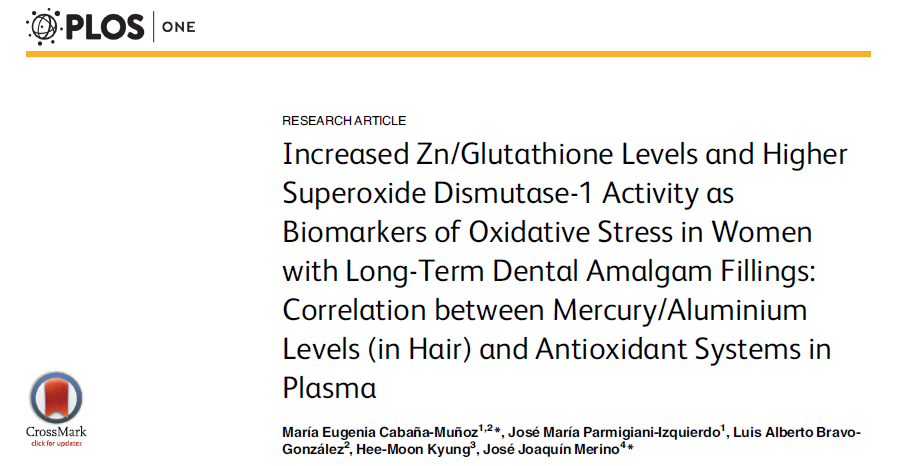Las mujeres que llevaron durante largo tiempo amalgama dental de mercurio (empastes de plata) evidenciaron un incremento significativo de Zn/glutatión y de la actividad de la superóxido dismutasa-1 (SOD-1). Además se observó una correlación entre los niveles de mercurio (Hg) y aluminio (Al) en pelo y dichos sistemas antioxidantes endógenos.

Título:
Increased Zn/Glutathione Levels and Higher Superoxide Dismutase-1 Activity as Biomarkers of Oxidative Stress in Women with Long-Term Dental Amalgam Fillings: Correlation between Mercury/Aluminium Levels (in Hair) and Antioxidant Systems in Plasma
Autores:
María Eugenia Cabaña-Muñoz, José María Parmigiani-Izquierdo, Luis Alberto Bravo-González2, Hee-Moon Kyung, José Joaquín Merino
Abstract:
Background:
The induction of oxidative stress by Hg can affect antioxidant enzymes. However, epidemiological studies have failed to establish clear association between dental fillings presence and health problems.
Objectives:
To determine whether heavy metals (in hair), antioxidant enzymes (SOD-1) and glutathione levels could be affected by the chronic presence of heavy metals in women who had dental amalgam fillings.
Materials and Methods:
55 hair samples (42 females with amalgam fillings and 13 female control subjects) were obtained. All subjects (mean age 44 years) who had dental amalgam filling for more than 10 years (average 15 years). Certain metals were quantified by ICP-MS (Mass Spectrophotometry) in hair (μg/g: Al, Hg, Ba, Ag, Sb, As, Be, Bi, Cd, Pb, Pt, Tl, Th, U, Ni, Sn, Ti) and SOD-1 and Glutathione (reduced form) levels in plasma. Data were compared with controls without amalgams, and analyzed to identify any significant relation between metals and the total number of amalgam fillings, comparing those with four or less (n = 27) with those with more than four (n = 15). As no significant differences were detected, the two groups were pooled (Amlgam; n = 42).
Findings:
Hg, Ag, Al and Ba were higher in the amalgam group but without significant differences for most of the heavy metals analyzed. Increased SOD-1 activity and glutathione levels (reduced form) were observed in the amalgam group. Aluminum (Al) correlated with glutathione levels while Hg levels correlated with SOD-1. The observed Al/glutathione and Hg/SOD-1 correlation could be adaptive responses against the chronic presence of mercury.
Conclusions:
Hg, Ag, Al and Ba levels increased in women who had dental amalgam fillings for long periods. Al correlated with glutathione, and Hg with SOD-1. SOD-1 may be a possible biomarker for assessing chronic Hg toxicity.
Ver artículo completo:
http://journals.plos.org/plosone/article?id=10.1371/journal.pone.0126339